An Exquisite Beaded Embroidery Sleeve
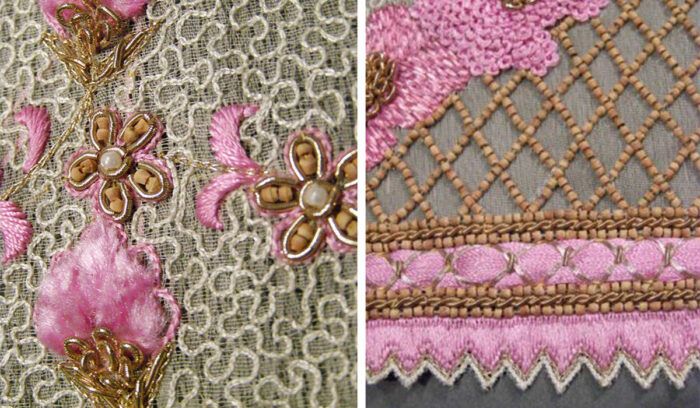
I recently came into possession of spectacular beading and embroidery on sleeves and a bodice. These pieces have needle embroidery, tambour embroidery (worked with a needle that looks like a tiny pointed crochet hook), and bullion work (worked with tiny metal coil, most times either gold, or gold-plated metal).
This post shows the sleeves. As you can see in the first photo, the sleeve was worked on ivory organza. The stitching lines were hand-basted onto the organza, and the entire piece was worked in a frame before it was cut out. This is called working “in the flat”.
As it came to me, it was cut out, with 1″ wide seam allowances.
Zooming in closely, reveals a universe of detail not apparent in a long shot. The ground pattern of stippling, is done with a fine tambour chain stitch. The flowers reveal a combination of beading, tambour chain stitch, satin stitch, bullion work, and chenille work.
This photo is the back of the work in this area–I like to look at the back almost as much as I like looking at the front.
Here’s detail of the branch…
…and detail of the bullion work and chenille.
Here’s the wrong side.
Further down the center of the sleeve, more of the motifs.
And a close-up of the same–with more bullion work, chenille, and tambour with gold thread.
And again, the back of the work.
The lower part of the sleeve has some lovely detail.
In addition to the beading and bullion work, the flowers show some beautiful thread embroidery, and tambour work.
Here’s the back of this portion.
Close-up of the flowers shows the beautiful embroidery (the “loopy” stitching), tambour embroidery (satiny stitches) and bullion work (centers of the flowers).
The back shows what the different stitching…
Start your 14-day FREE trial to access this story.
Start your FREE trial today and get instant access to this article plus access to all Threads Insider content.
Start Your Free TrialAlready an Insider? Log in


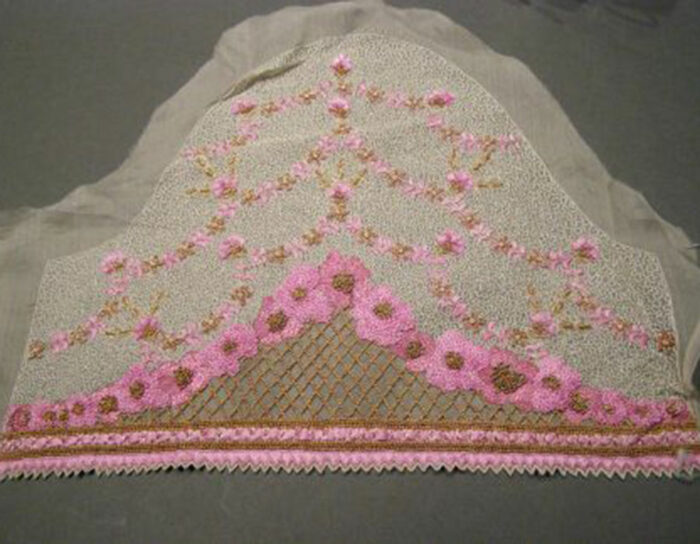
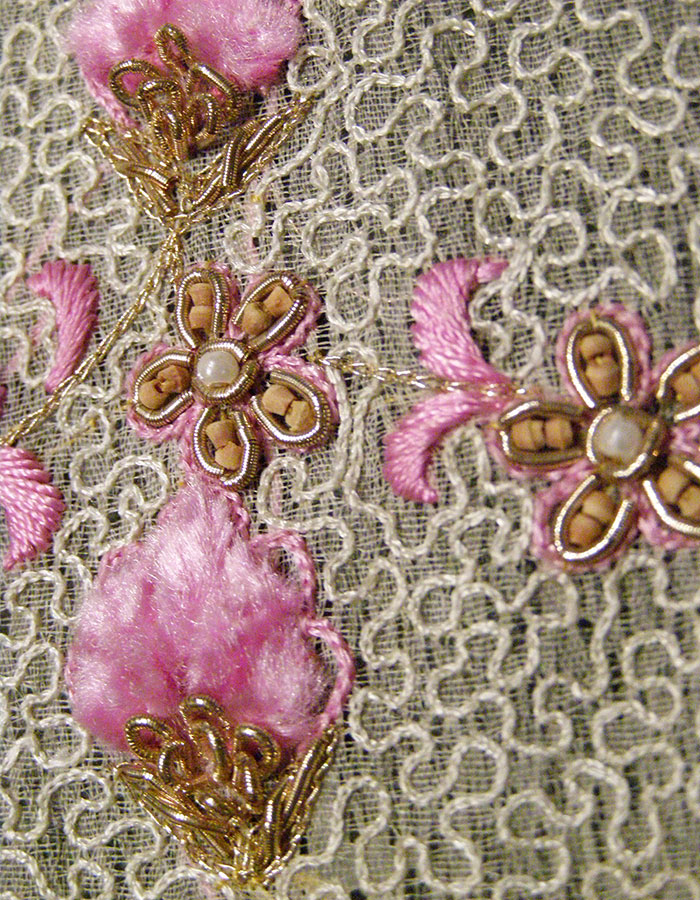

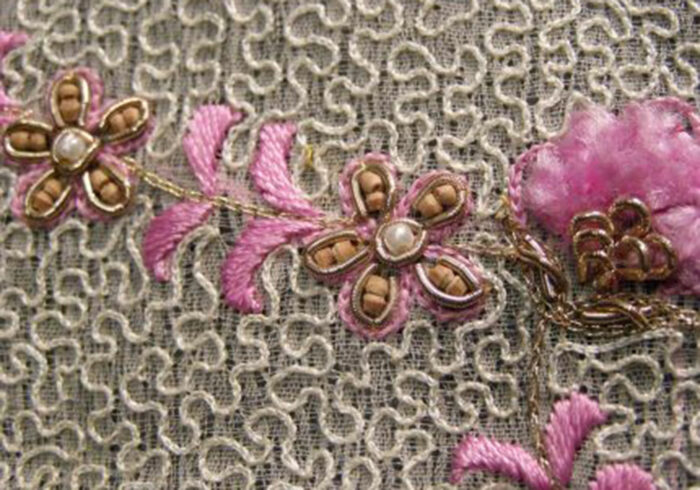
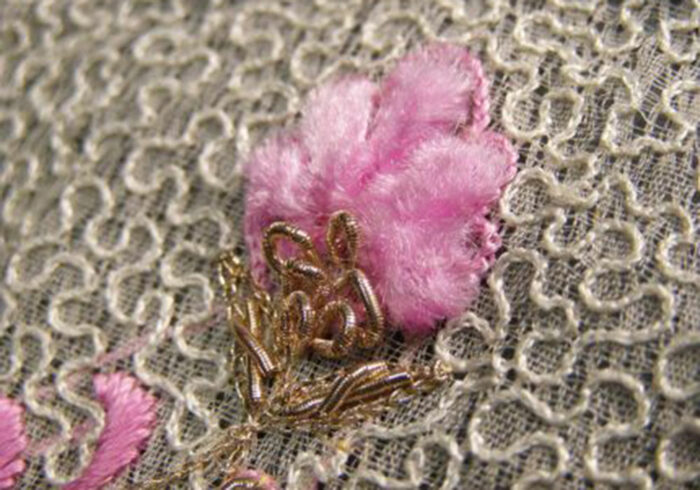

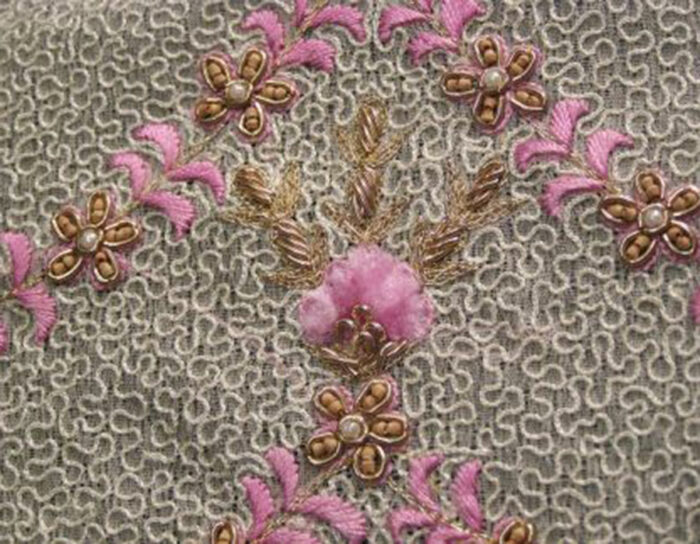
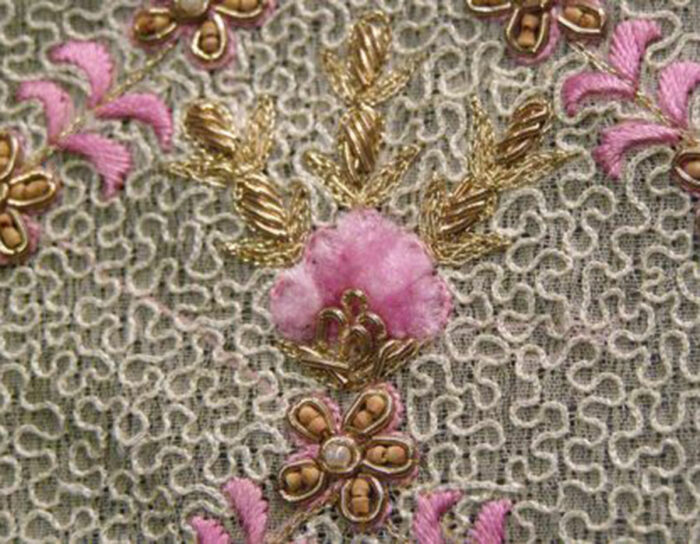
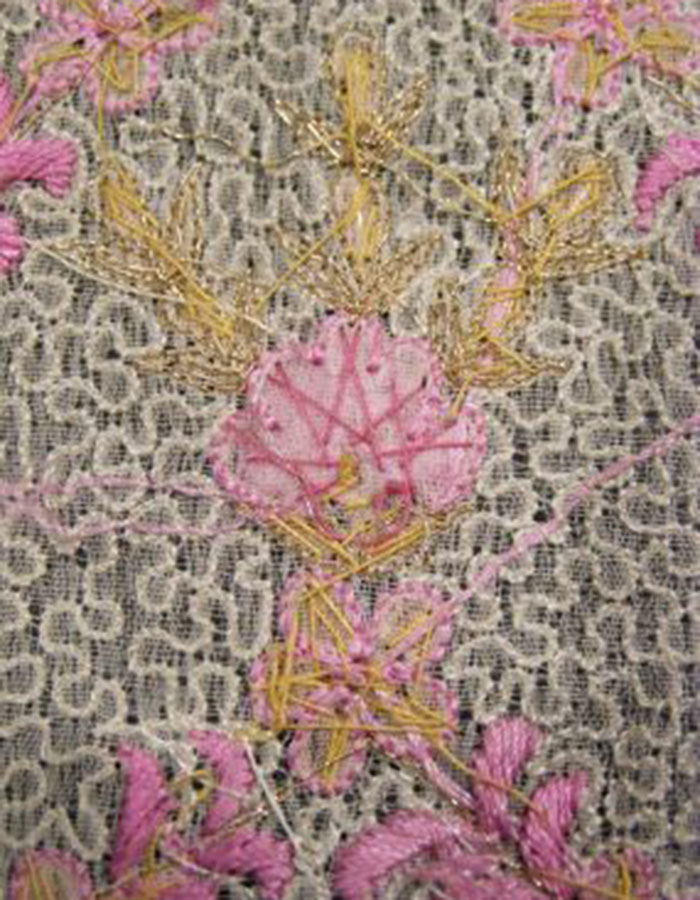

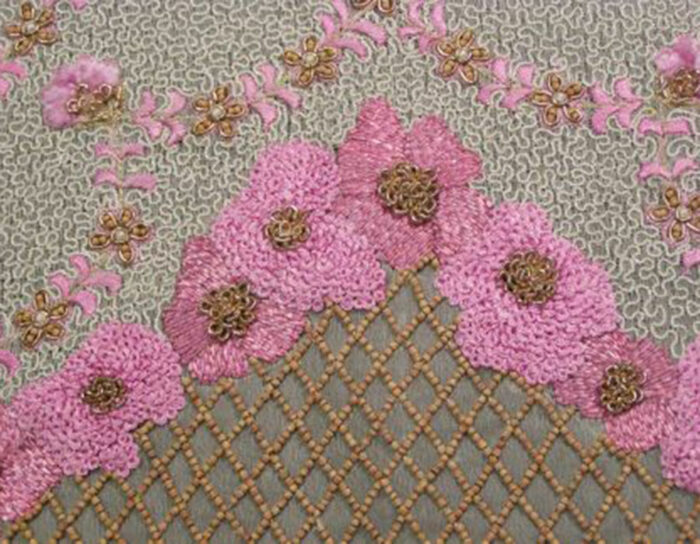
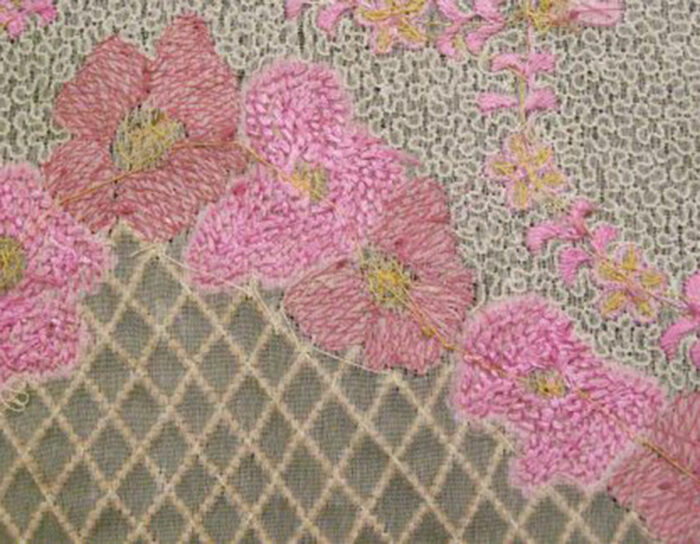
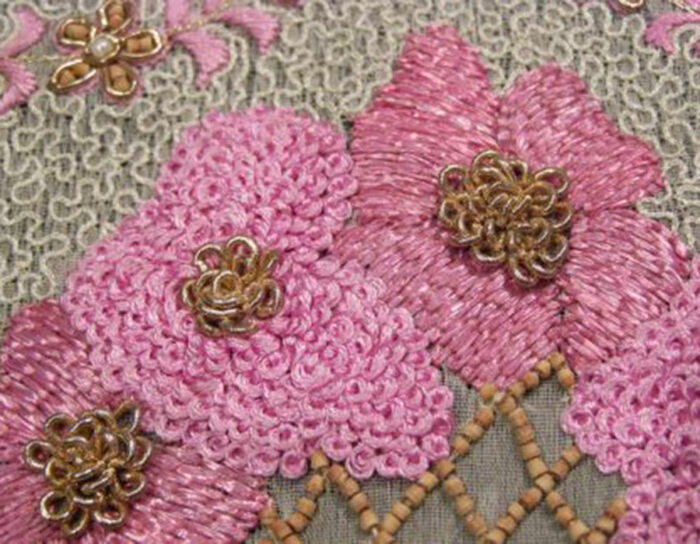





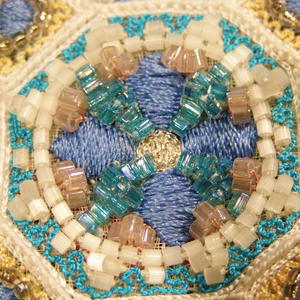






























Hi Kenneth, What a gorgeous example of handwork! Thank You for sharing it! Its true eye candy!
Wow! I am overwhelmed! Thank you so much for sharing this with us. Do you know the history, such as when and where this was made, and for what occasion?
I love it. What a lovely example.
Call me weird, but those bullion stitches do it for me!!! Since I've recently started an embroidery project, this caught my interest. What an absolutely exquisite example of couture hand work!!! So beautiful it almost makes me cry!!!
I too, would love to know where it comes from and for what it was made??
Thank you so much for sharing this priceless find!!! Have you decided what you're going to do with it? Incorporate it into a formal garment, or.......???
How many hours would this involve do you think? Where is it from? India? It is simply marvelous... What a generous share. Thank you
So beautifully finished and exquisitely executed. Time, skill, creativity...all exceptional. I love fussy stuff like this which is tastfully done. Sometimes it can be overdone and become gaudy. Thanks for the peaks at the back of the work.
That is my question too... is it Middle Eastern?
An elaborate costume or celebration dress?
Oooooooooh's and Ahhhhhhhhh's! However do you find these gems! Loved it.....can't wait for more photos!
I love it. Can't wait until I have dress to use it on.
Stunningly gorgeous. Simple beautiful at the same time and in one of my favorite colors - Pink! Would love to see what you will be doing with this or do you tuck it away and bring it out just to drool over it?
Absolutely beautiful! A real work of art.
Thank you.
Thank you sooooo much for the incredibly detailed photos, Kenneth, especially of the back of this treasure! That's *almost* as good as having the piece in hand, and as close as we'll probably ever get!
Happy Spring, all!
I think that it is very sad that whomever did all this work never put it together as a dress. It is aweinspiring. I never even knew such complex handwork existed.
Such an inspiration!
Any dress could not live up to this sleeve! I see them as a pillow, maybe for Easter, that is egg shaped! Put the to straight edges together and add a wide organza ruffle all around. Beautiful and something you could pass down, not just hang in the closet;-)
Kenneth, there isn't a huge amount of beading, but it is quite covered with handwork. I've been reluctant to do this to a whole garment piece worked on organza. Does it seem frail or maybe the handwork actually fortifies it? I know appliques are frequently worked on organza. Is it common for whole pieces to be worked on organza? Does one give up any quality by using durable synthetic rather than silk organza? Would it be wise to use synthetic or silk for something like this piece?
I notice that the stitcher allows the yellow thread to travel between areas on the back. It's really not noticeable on the front, is it? That's good to know.
Thank you for sharing this piece. I can appreciate the stitcher's design and creativity. I always wonder how much was planned and what was decided "on the fly".
Glad you all like this post!
As I understand it, the work is from India, but exceptional quality. This is one of a pair of sleeves, that were made as a sample for a designer but not used. I'm keeping them as a good example, not using them in any project. Somehow using them in a piece, seems disrespectful.
As for the question of working on organza, it's a common practice but not always done, especially for tambour work, as it's called. This is because, for many of the stitches, the design is marked on the back of the work, and the front is face down. If the embroiderer can see through the fabric to do the work, this is a distinct advantage. The chenille work, as well as the bullion work, though, is done with the work face up.
The question about appliques: These are done on organza--I've seen man-made as well as silk fiber organza used. Working on the organza reduces bulk, so that when the applique is sewn to the garment, you control the thickness built up in that area.
My understanding, is that this is mostly done on silk organza, but I don't see why a man-made fiber couldn't be substituted--as a matter of fact I personally prefer it. Man-made fibers will last longer than natural fibers. But when making, or purchasing this kind of work, durability isn't the primary concern.
Regarding the yellow thread funning across the back, it doesn't show from the front because the other ornament is dense enough to hide it. This garment most likely would have been lined with another layer of the silk organza, to tidy up the inside and keep the stitches from scratching the wearer.
An additional comment on the tambour embroidery--if you can see the "loops" of the chain stitch on the face side of the embroidery, that means that the piece was worked face side up. As you can see on this example, there's quite a bit of the chain stitch visible on the front, which means the design was worked face side up.
When the tambour work is done with the face side down, the stitching will look like a machine straight stitch on the face side.
Beautiful piece and how timely! For those interested in learning more about this sort of work, I will be teaching a class on Couture Style Beadwork (including an introduction to tambour) in Columbus, Ohio. at the Columbus College of Art and Design on June 18th -22nd. You can register here: http://www.ccad.edu/cefinder/detail?class=608
Thanks for all you do. You're an inspiration! It's amazing how you can always find the very best of the best to share.
That IS absolutely exquisite! What lost arts we have relinquished in favor of faster achievements. Thank you!!
Thank you for your reply, Kenneth. I've been curious about tambour work recently. I think I'll go ahead and order a set of hooks and give it a whirl. I like that you can use it for beading or for chain stitch on the front. That stippling effect is really neat.
Hi Kenneth A beautiful example of hand embroidery. My Bernina agent keeps trying to get me to buy the embroidery side of my machine and I always tell her "hand embroidery is far more relaxing and beautiful". I know it's slow but is really worth the effort. Thankyou for sharing. Maggie
Spectacular! I know what you mean about being disrespectful to the piece of needlework. I had similar feelings over some exquisite liturgical lace I inherited.
What a wonderful piece of embroidery, thanks for all the detailed close-ups.
I am a little confused though. I was looking for the tambour work amongst the large flowers (pictures 13 and 14) but cannot see this. To me it looks like the flowers which do not have the loopy stitch are couched. The satiny flowers look as if the stitch is straight rather than a chain stitch and it appears that the embroidery floss is held down with a much thinner thread. You can see this on the image showing the backside.
Please correct me if I'm wrong.
Thanks
Ulrike
The tambour work on the non-loopy large flowers is a chain stitch worked in a zig zag pattern, where the loops are pulled up through the fabric to lie parallel n the front, but look like a zig zag from the back. It's a little hard to explain but a correspondent of mine looked at the piece and pronounced that this was indeed tambour, and he's in the business, so I took him at his word.
Hi Kenneth - Your comment brought a huge smile to my face .. Indeed the work is of exceptional quality .. even if it's from India :-) ..
But .. this almost pales in comparison to some of the work done there .. I might know .. not only am I from India, but I've just returned from a trip after interacting firsthand with artisans who do astoundingly beautiful work in breathtakingly dismal surroundings! I'll be sure to bring back some stuff for you next time :-)
I still have very fond memories of you (and your dog) from the Moulage class you taught (eons ago) when you lived in the SF Bay Area .. I'm an avid follower of your contributions to the magazine! Luuuv the stuff you do!
I realize in retrospect that the comment about India was out of bounds, and apologize for it. In the rag trade, we see the low end of embroidery from India (as well as other countries) which was where that comment came from, which doesn't excuse it.
I'd love to see the beautiful work that they do there, as would others here I'm sure. If there's a way to post it here, please, do?
Thanks for the kind words, about my work, the Moulage class, and my doggie (may she rest in peace)!